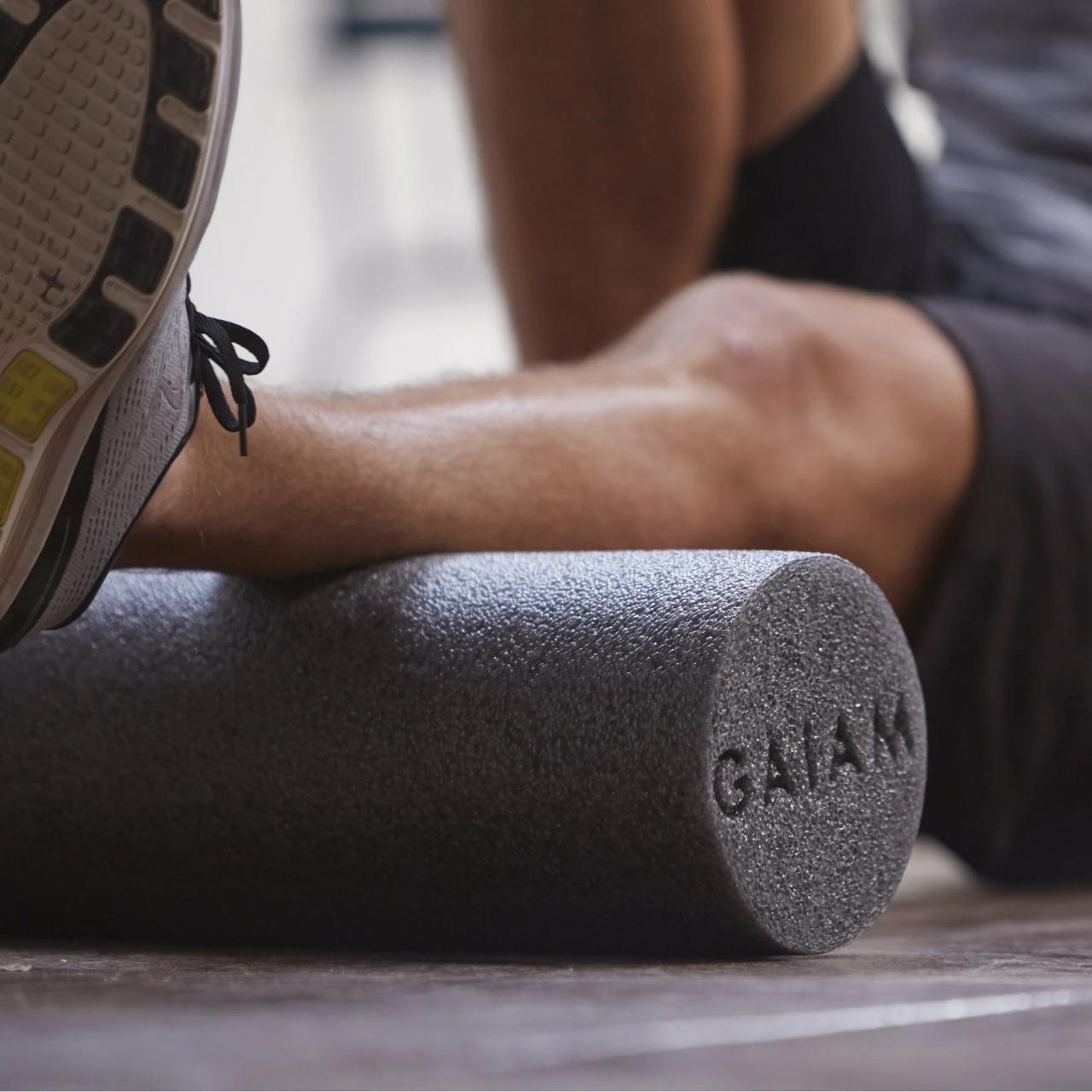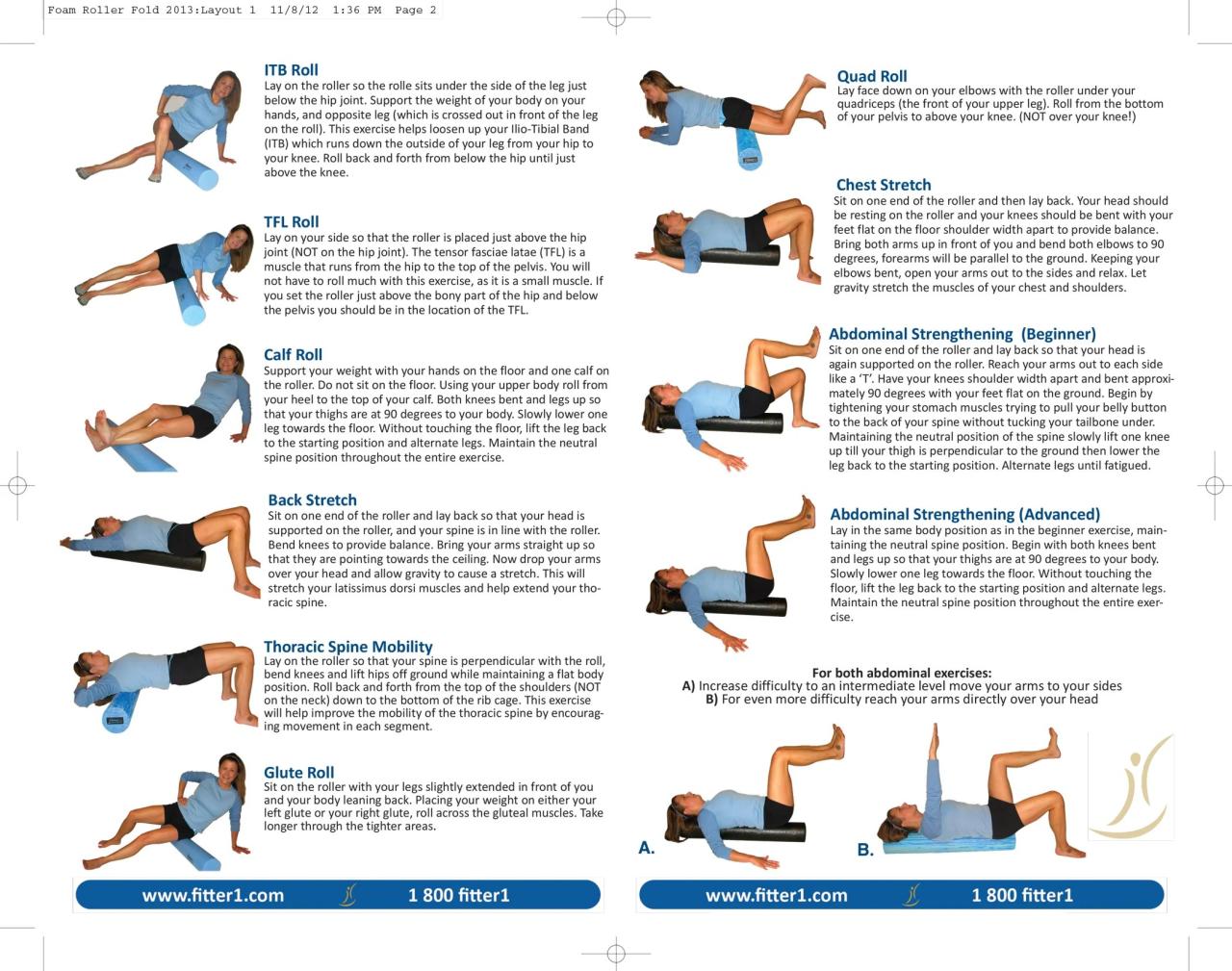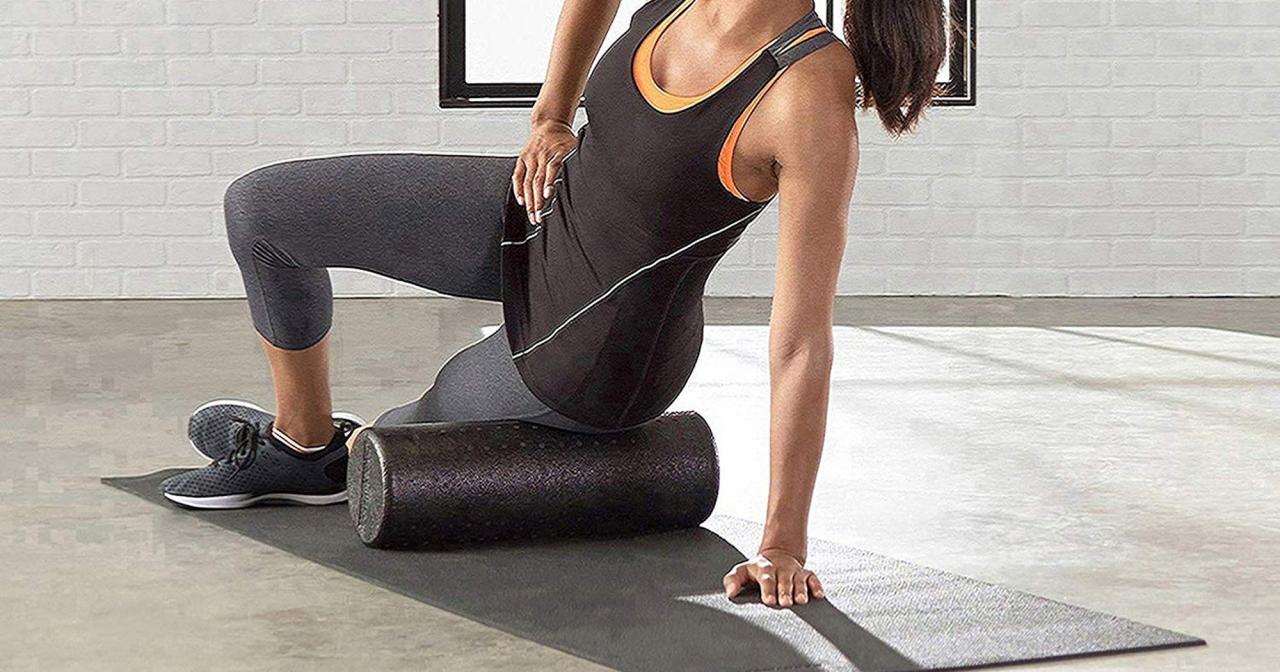Foam roller – Embark on a journey into the world of foam rolling, where muscles find relief, flexibility flourishes, and pain diminishes. From recovery to performance enhancement, foam rolling has emerged as an indispensable tool for fitness enthusiasts of all levels.
In this comprehensive guide, we’ll delve into the myriad benefits of foam rolling, explore the diverse types available, and provide step-by-step techniques for effective self-massage and assisted rolling. We’ll also showcase a range of foam rolling exercises targeting specific muscle groups, ensuring you reap the full benefits of this remarkable practice.
Foam Roller Benefits
Foam rolling is a self-massage technique that involves using a cylindrical foam roller to apply pressure to different muscle groups. It offers numerous benefits for fitness enthusiasts and individuals seeking pain relief.Foam rolling can enhance muscle recovery by promoting blood flow and reducing muscle soreness.
The pressure applied to the muscles helps break down adhesions and knots, improving flexibility and range of motion. Additionally, foam rolling can alleviate pain by reducing muscle tension and promoting relaxation.
Incorporating Foam Rolling into Fitness Routines
Foam rolling can be incorporated into various fitness routines, including:
- Pre-workout:Foam rolling before a workout can help activate muscles and improve flexibility, preparing the body for exercise.
- Post-workout:Foam rolling after a workout can reduce muscle soreness, improve recovery, and promote relaxation.
- As a standalone exercise:Foam rolling can be performed as a standalone exercise to target specific muscle groups and improve overall flexibility.
By regularly incorporating foam rolling into your fitness routine, you can reap its numerous benefits and enhance your overall well-being.
Types of Foam Rollers
Foam rollers come in various types, each with unique features and uses. Understanding these variations can help you choose the most suitable roller for your individual needs and fitness goals.
Standard Foam Rollers
Standard foam rollers are cylindrical in shape and typically made of firm, high-density foam. They provide a deep and intense massage, targeting larger muscle groups and fascial tissues. These rollers are ideal for individuals seeking a rigorous massage experience.
Textured Foam Rollers
Textured foam rollers have raised patterns or bumps on their surface, providing a more stimulating massage experience. These patterns can help break up muscle knots and adhesions, enhancing circulation and promoting relaxation. Textured rollers are suitable for individuals who prefer a deeper, targeted massage.
Vibrating Foam Rollers
Vibrating foam rollers incorporate a vibrating mechanism that delivers pulsations during use. These vibrations enhance the massage experience by increasing blood flow, reducing muscle soreness, and promoting relaxation. Vibrating rollers are a good option for individuals seeking a more therapeutic and invigorating massage.
Choosing the Right Foam Roller
When selecting a foam roller, consider your fitness goals, experience level, and personal preferences. Standard foam rollers are a versatile choice for beginners and experienced users alike. Textured rollers are ideal for individuals seeking a deeper massage, while vibrating rollers offer a more therapeutic experience.
Ultimately, the best foam roller for you is the one that meets your specific needs and provides the desired massage intensity.
Foam Rolling Techniques

Foam rolling is an effective self-massage technique that can help improve muscle flexibility, reduce muscle soreness, and promote relaxation. To use a foam roller effectively, it is important to use the proper techniques.
There are two main types of foam rolling techniques: self-massage and assisted rolling. Self-massage involves using the foam roller on your own body, while assisted rolling involves having someone else help you use the foam roller.
Self-Massage Techniques, Foam roller
- Roll slowly and deliberately.Do not rush through the rolling process. Take your time and focus on each muscle group.
- Apply pressure to the muscle group.The amount of pressure you apply will depend on the muscle group you are rolling. For example, you will need to apply more pressure to the quadriceps than the calves.
- Hold each position for 30-60 seconds.This will give the foam roller time to work into the muscle tissue and break up any knots or adhesions.
- Breathe deeply.Foam rolling can be intense, so it is important to breathe deeply throughout the process.
Assisted Rolling Techniques
- Find a partner who is willing to help you.Your partner should be able to apply pressure to the muscle group you are rolling.
- Lie down on the floor or on a table.Your partner should stand behind you and place their hands on the muscle group you are rolling.
- Have your partner apply pressure to the muscle group.Your partner should apply pressure slowly and deliberately.
- Hold each position for 30-60 seconds.This will give the foam roller time to work into the muscle tissue and break up any knots or adhesions.
- Breathe deeply.Foam rolling can be intense, so it is important to breathe deeply throughout the process.
Foam Roller Exercises
Foam rolling is an effective self-massage technique that can improve flexibility, reduce muscle soreness, and enhance overall mobility. To maximize the benefits of foam rolling, it’s essential to perform exercises that target specific muscle groups with proper form and technique.
This comprehensive guide provides a detailed list of foam roller exercises, organized into difficulty levels for beginners, intermediates, and advanced users. Each exercise includes step-by-step instructions and illustrations to ensure proper execution.
Beginner Exercises
- Calf Roll:Sit on the floor with legs extended and feet flexed. Place the foam roller under your right calf and slowly roll back and forth, applying gentle pressure.
- IT Band Roll:Lie on your side with the foam roller positioned perpendicular to your body, just below your hip bone. Slowly roll up and down the length of your IT band, applying moderate pressure.
- Quad Roll:Kneel on the floor with the foam roller under your right thigh, just above the knee. Slowly roll back and forth, applying firm pressure.
Intermediate Exercises
- Hamstring Roll:Lie on your back with the foam roller under your right hamstring, just above the knee. Slowly roll up and down the length of your hamstring, applying firm pressure.
- Glute Roll:Sit on the foam roller with your feet flat on the floor. Slowly roll back and forth, applying firm pressure to your glutes.
- Latissimus Dorsi Roll:Lie on the foam roller with your right arm extended overhead. Slowly roll back and forth, applying moderate pressure to your latissimus dorsi muscle.
Advanced Exercises
- Piriformis Roll:Sit on the foam roller with your right leg crossed over your left. Slowly roll back and forth, applying firm pressure to your piriformis muscle.
- Erector Spinae Roll:Lie on the foam roller with your arms crossed over your chest. Slowly roll back and forth, applying firm pressure to your erector spinae muscles.
- Shoulder Roll:Lie on your back with the foam roller under your right shoulder blade. Slowly roll up and down the length of your shoulder, applying moderate pressure.
Foam Roller Safety

Foam rolling offers numerous benefits, but it’s essential to practice it safely to avoid potential risks and injuries.
Before using a foam roller, it’s crucial to consult with a healthcare professional, especially if you have any underlying health conditions or injuries. Additionally, proper technique is key to maximizing the benefits and minimizing risks.
Common Mistakes and Injuries
- Over-rolling:Applying excessive pressure or rolling too frequently can cause muscle soreness, bruising, or inflammation.
- Rolling too quickly:Rushing through the process can prevent the muscles from releasing tension effectively.
- Rolling on sensitive areas:Avoid rolling directly on bones, joints, or open wounds.
- Ignoring pain:If you experience pain during foam rolling, stop immediately and consult a healthcare professional.
Tips for Safe Foam Rolling
- Listen to your body:Pay attention to how your body responds to foam rolling. If you feel pain or discomfort, adjust the pressure or stop rolling.
- Start gradually:Begin with short sessions and gradually increase the duration and intensity as your body adapts.
- Use proper technique:Roll slowly and smoothly, focusing on releasing tension in specific muscle groups.
- Hydrate:Staying hydrated helps improve muscle recovery and reduce soreness.
Conclusion

As you incorporate foam rolling into your fitness routine, you’ll discover a renewed sense of muscle recovery, flexibility, and well-being. Remember to listen to your body and seek professional advice if any discomfort arises. Embrace the transformative power of foam rolling and unlock a world of fitness possibilities.
Q&A
What is the primary benefit of foam rolling?
Foam rolling promotes muscle recovery by reducing muscle tension, improving blood flow, and enhancing flexibility.
How often should I foam roll?
Foam rolling can be incorporated into your routine as often as daily or as infrequently as once a week, depending on your fitness level and individual needs.
Can foam rolling be harmful?
Foam rolling is generally safe when performed correctly. However, it’s important to avoid excessive pressure or rolling over bony areas. If you experience any discomfort, stop rolling and consult a healthcare professional.